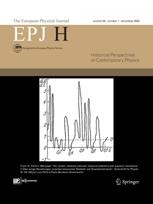The importance of the 1949 Florence conference “StatPhys I” to physics
The first international conference devoted to statistical mechanics was also of great importance to scientific reconstruction in post-war Italy.
New York | Heidelberg, 11 July 2024
 International science conferences are now a fixture in the calendar of most scientists. These face-to-face meetings allow researchers to gather and exchange the latest information, thus maintaining the scientific culture of the relevant disciplines by emphasising that no one researcher is an island.
International science conferences are now a fixture in the calendar of most scientists. These face-to-face meetings allow researchers to gather and exchange the latest information, thus maintaining the scientific culture of the relevant disciplines by emphasising that no one researcher is an island.
Statistical physics, or statistical mechanics as it was once known, is the branch of physics that deals with the application of statistics to large systems, usually groups of particles. It, too, has its own international conferences, the origin of which goes back to the 17th to the 20th of May 1949 when around 70 physicists from eight countries met in Florence, Italy. This conference would later come to be regarded as “StatPhys I” with StatPhys referring to International Conferences on Statistical Physics, the series of conferences organised by the IUPAP.
A new paper published in the journal EPJ H: Historical Perspectives on Contemporary Physics discusses the importance of the 1949 statistical mechanics conference not just for physics but also for Italy’s post-war reemergence. The paper is authored by Roberto Lalli, Assistant Professor at the Polytechnic University of Turin and Visiting Scholar at the Max Planck Institute for the History of Science, and Paolo Politi, of the Florence Unit of the Institute for Complex Systems, who teaches statistical physics at the University of Florence.
“The StatPhys series is highly regarded in the international physics community because statistical physics spans many physics sub-disciplines and has a unique epistemic status. It connects with various physics fields, making its boundaries fluid and the community-building process particularly fascinating,” Lalli said. “As a consequence, the event which gave rise to this important and unique tradition is particularly interesting from the historical perspectives.”
Lalli explained that interest in this conference extends beyond its foundational role in this sub-discipline of physics. Not only was it essential for international community building after World War II, but the timing and location of the event added considerable historical relevance. That is because this was the first international physics conference organised in Italy by the Italian Physical Society after the war.
“This conference offers a compelling historical case to understand the international reorganisation of science and the reconstruction of Italian physics amidst growing internationalisation after the destruction of a terrible war,” Politi said. “It provides a unique opportunity to explore several processes that shaped international science, the creation of physics sub-disciplines, the role of international scientific organisations, and the relationships between national physics communities and international bodies during this pivotal period, characterised by rapid political, economic, social, and cultural transformations.”
“Seventy-five years later, the Florence conference continues to have an impact especially thanks to the scientific contribution of Lars Onsager and next year, with the organisation of StatPhys29, Florence will return to being at the centre of statistical physics.”
Politi added that it is perhaps surprising that many physicists devoted so much effort to the organisation of such events at the time. The reason for this effort, he continued, is that these scientists considered international conferences crucial for the development of a field, for shaping future research agendas, and for helping the reconstruction of physics in Italy.
“Sometimes, this is overlooked in our current perspective when we take these gatherings for granted,” Lalli concluded. “At the time, they were still considered exceptional.”
Reference: Lalli, R., Politi, P. The birth of StatPhys: the 1949 Florence conference at the juncture of national and international physics reconstruction after World War II. EPJ H 49, 16 (2024). https://doi.org/10.1140/epjh/s13129-024-00079-2
Further Information
For more information visit: www.epj.org
Services for Journalists
The full-text article is available here.
Contact
Sabine Lehr | Springer | Physics Editorial Department
tel +49-6221-487-8336 | sabine.lehr@springer.com
